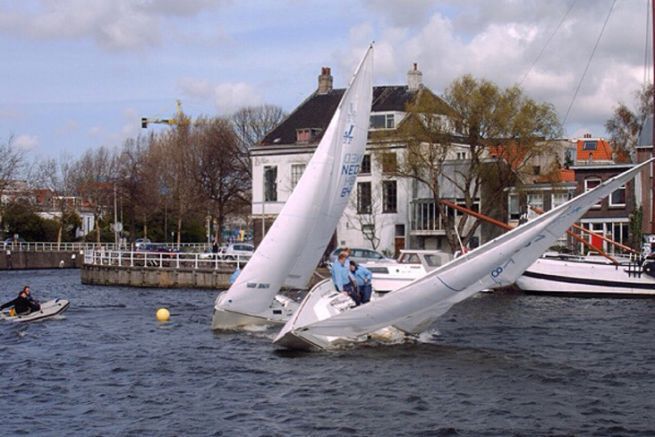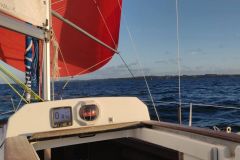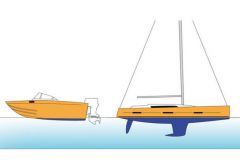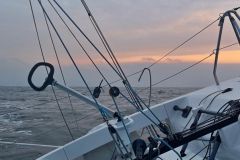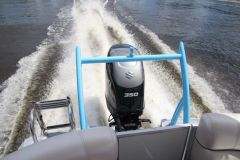The wind is rarely constant in strength and direction, so let's savour it when it is. As soon as conditions are a little unstable, either because of terrain or weather conditions, the wind will keep changing in strength and direction. In fact, the wind forecast in the observations is an average over 10 minutes.
So since we have to deal with this capricious wind, here are a few tips on how to take advantage of the ripples in regattas and cruises.
A crew member must announce the laughing stock
In gusty weather, a crewmember should be tasked with announcing the laughs by doing a countdown "5, 4, 3, 2, 1, Risée?!". The crewmember must be focused on the water surface to windward in 3/4 forward of the boat upwind and 3/4 aft downwind. Darker, shivering water will help identify the gust.
The task is as delicate as it is exciting. As experience comes one becomes more and more seasoned and precise in assessing distance, strength and even the direction of the mockery.
Communicating with the helmsman and trimmers
This gust announcement allows the crew to act accordingly. Upwind, we know that a constant and reasonable angle of heel must be kept to limit the drift, the helmsman must eventually wave to the wind and shock the mainsail to accompany the increase in wind.
Downwind, when a gust hits the boat, the pressure increases in the sails and it accelerates. When sailing downwind, especially in light winds, you can count on the boat accelerating sharply, hence the importance of looking behind and being ready to gybe to follow or stay in a reef.
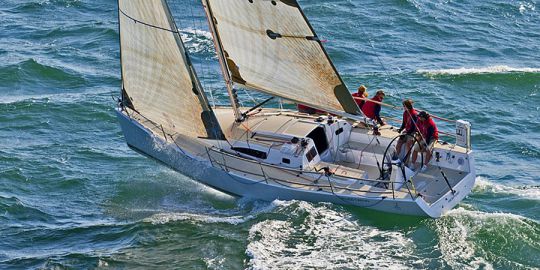
The role of recall
The laughing stock will spice up the lives of the crew on the recall. There's no longer any question of sitting quietly and letting your thoughts wander between tacks. Here, the role of the crew is paramount in controlling the trim. If the boat heels over, the keel and rudder instantly lose their effectiveness and you start to slip.
When the gust is announced, the crew must be ready to put their full weight on the lines, arms and legs as far outboard as possible. And as soon as the wind dies down, the crew who feel the inclination diminishing must limit their withdrawal from the lines, or even withdraw from the lines.
Keeping control
Upwind, reefing can cause the boat to "pass over the helm". As the heel increases, the rudder loses its effectiveness and the hull effect causes the boat to move upwind. As the helmsman tries to turn the rudder, he gives the rudder such an angle that it digs in and unhooks the water. The boat no longer responds and "goes over the helm". It is essential to avoid this uncontrolled slipping, and the trimmers, especially the trimmers for the mainsail, must be ready to shock.
Also downwind there is a risk of leaving the lof, with the same consequences. If the boat is heeled too much and the rudder is "overloaded" you can lose control in the same way.
The reefing information will allow you to be ready to release the mainsail downhaul and ease the spinnaker sheet to "unload the rudder" and maintain control to trim into the reef.

Keeping your lodging reasonable
When the gust hits the boat, the whole crew must succeed in crossing this ridge either by supporting it when the wind is strong or by taking advantage of it when it is lighter. Upwind, if the wind is strong, you should not hesitate to sail with the headsail guide down - if this allows you to keep a reasonable angle of heel. Downwind, in the gust, you can take advantage of being able to go down more than usual by using to your advantage the apparent wind which comes a little further to the side (it refuses).
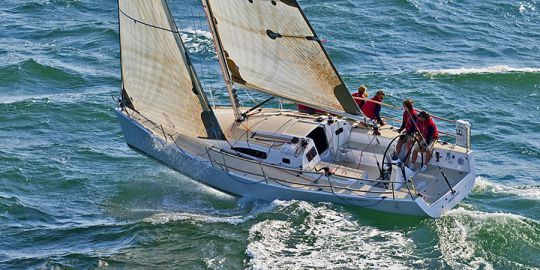
Being focused
Unstable wind conditions require extra concentration to react and adapt to the new conditions. Sailing is more delicate and even more exciting, as you have to be attentive to your external environment and interact with the sailboat. You are the interface between the outside and the sailboat. By anticipating the moment when the reef will hit the boat, we will be able to act on the sails and the helm.
The patatras and the bastaques
In a gust, the backstay and runners must be tightened to block the rigging. Once the tension is correct, fine-tuning can be started. Pulling on the masthead will bend the mast to flatten the sails and open the falls. With a reduced backstay, a dynamic adjustment in the reefing area will release the power, and if this is not enough, you will have to act on the traveller and then the sheet.
